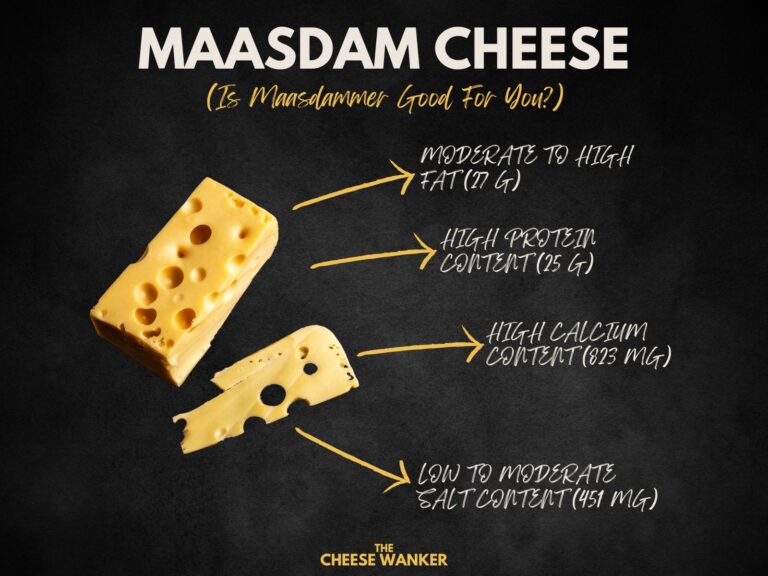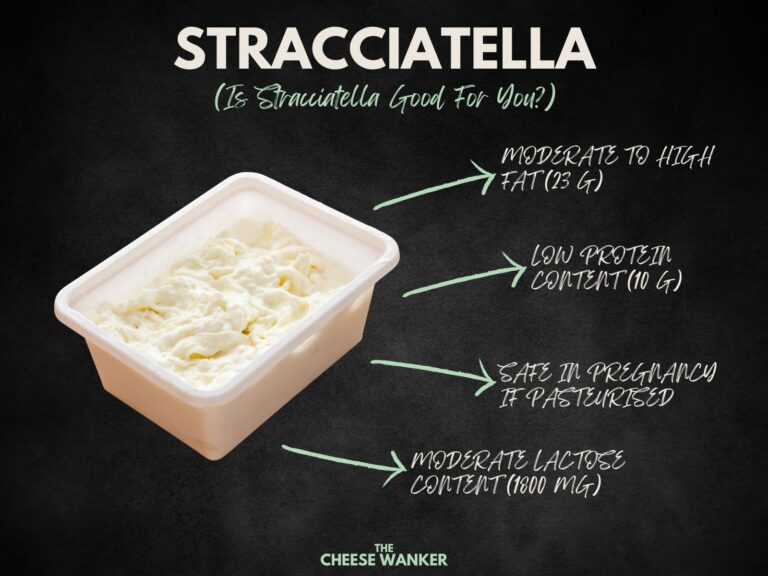Together with Gouda, Edam is easily one of the most famous exports from the Netherlands. This pressed uncooked cheese is made with partially skimmed cow’s milk and gets its name from the town of Edam in North Holland. Read on to discover the nutrition facts for Edam cheese.
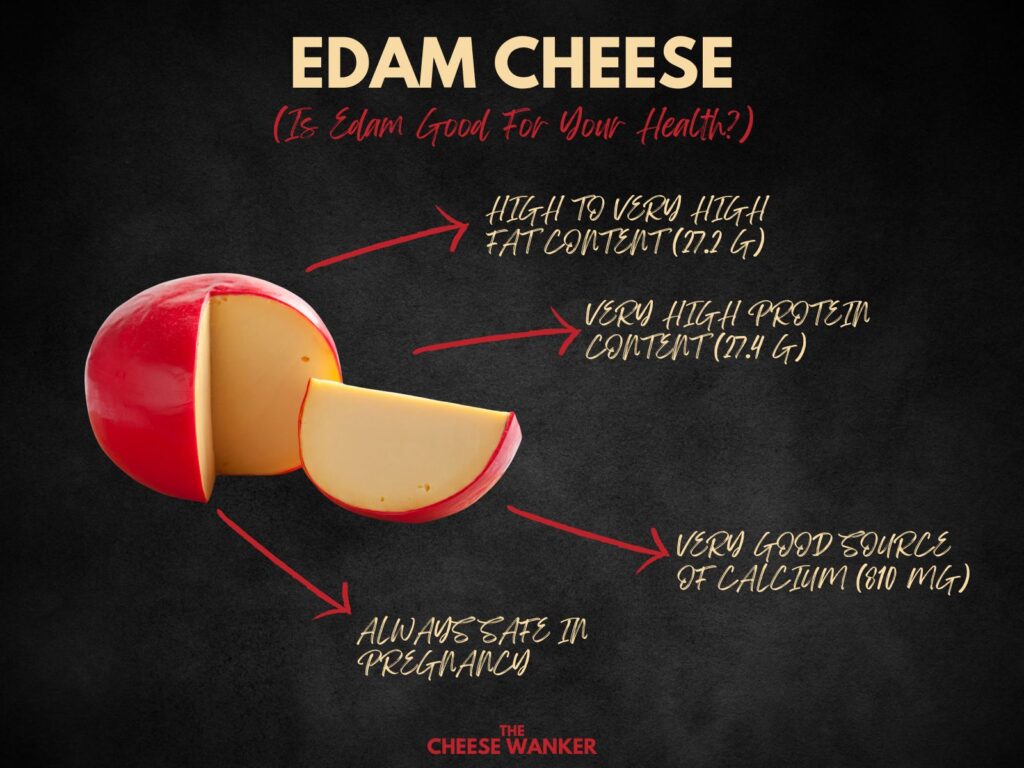
SEE ALSO: Nutrition facts for popular world cheeses in The Cheese Wanker’s index →
What is Edam cheese?
Edam cheese is a semi-hard cheese traditionally made from cow’s milk. Its origins date back to the town of Edam in North Holland, where it was first produced in the 12th century.
Known for its pale-yellow paste and characteristic round shape, Edam cheese has a mild, slightly salty taste. It’s versatile, suitable for slicing, grating or melting, making it a popular choice for sandwiches, snacks, and cooking.
Nutrition fact sheet
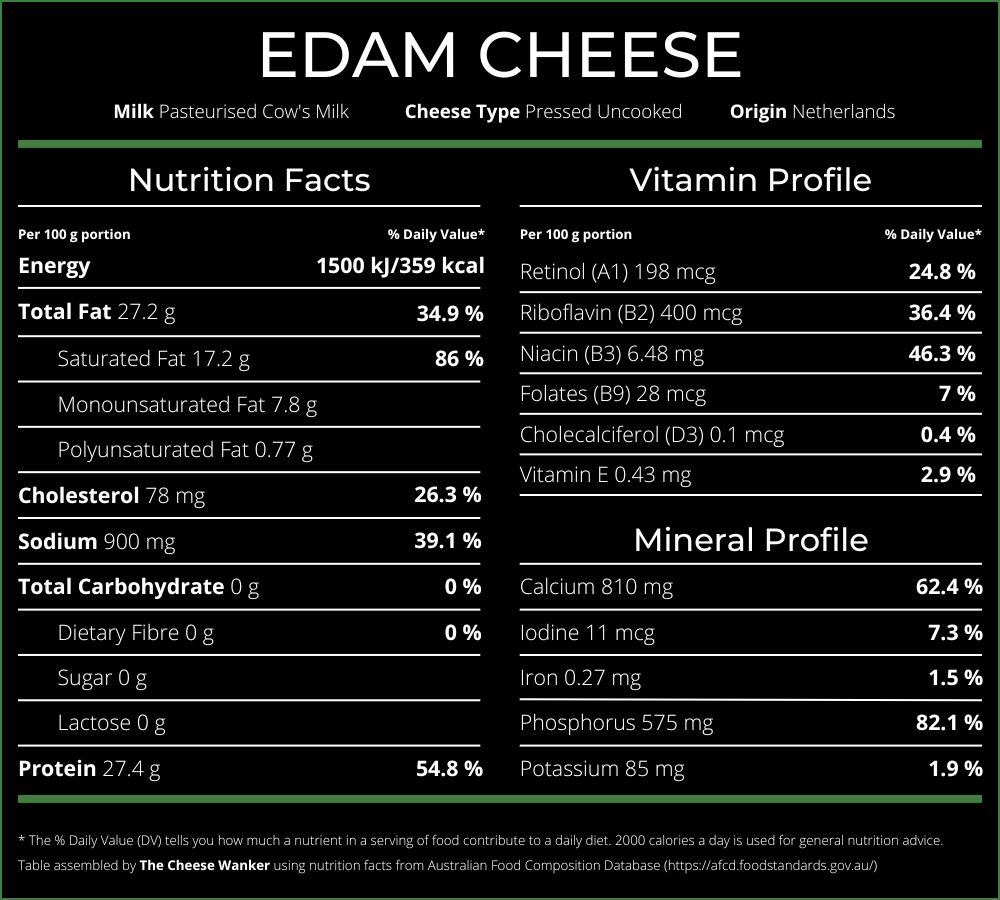
Nutritional review for Edam
Eating healthy plays a pivotal role in maintaining overall well-being and preventing chronic diseases. A balanced and nutritious diet provides our bodies with essential vitamins, minerals, and macronutrients, fuelling optimal physical and cognitive function.
With this in mind, let’s delve into the nutritional profile of Edam cheese.
Sample cheeses used
The majority of nutrient data were derived from a composite of 6 samples of Australian Edam (including Mainland, Bodalla, South Cape and Bega) and 2 samples of Dutch Edam (commercial brands) purchased in Sydney, Australia.
Calorie count
With approximately 359 calories per 100 grams, Edam cheese provides a moderate energy contribution. However, it’s essential to note that calorie count alone does not determine a food’s healthiness.
It’s the overall nutritional composition and portion size that matter most.
Fat content
Edam cheese is rich in fat, with a total fat content of 27.2 grams per 100 grams, of which 17.2 grams are saturated fat.
Saturated fats are known to raise LDL (bad) cholesterol levels, increasing the risk of heart disease. However, Edam also contains unsaturated fats, which, when consumed in moderation, can have beneficial effects on cardiovascular health.
You can learn more about the different types of fat in cheese and which cheeses have the lowest fat content here.
Protein content
Moreover, Edam boasts a high protein content of 27.4 grams per 100 grams. The protein in Edam is predominantly casein providing essential amino acids necessary for various bodily functions.
Protein is vital for muscle repair, immune function and satiety, making Edam cheese a valuable protein source.
Want to find out which cheeses have the highest protein content? Click here for our blog post covering cheeses with the highest protein content.
Cholesterol content
Next, Edam cheese contains approximately 78 milligrams of cholesterol per 100 grams.
Contrary to previous beliefs, dietary cholesterol from foods like cheese has a minimal impact on blood cholesterol levels for most people. However, individuals with specific health conditions may need to monitor their cholesterol intake.
You can learn more about the impact of dietary cholesterol on blood cholesterol levels in our dedicated post here.
Salt content
Furthermore, Edam cheese is relatively high in salt, with around 900 milligrams per 100 grams. The saltiness in Edam cheese enhances its flavour and acts as a preservative.
However, excessive salt intake is linked to hypertension and cardiovascular diseases. People with hypertension or at risk of heart disease should moderate their consumption of high-salt foods like Edam cheese.
You can read more about why salt is important in cheesemaking in our comprehensive post here.
Calcium content
On the other hand, Edam is an excellent source of calcium, providing approximately 810 milligrams per 100 grams.
Calcium is essential for maintaining strong bones and teeth, muscle function and nerve transmission. Incorporating calcium-rich foods like Edam cheese into your diet can help meet daily calcium requirements.
You can read more about this important mineral and find out which types of cheeses have the highest calcium content in our post here.
Other vitamins & minerals
Edam cheese is also high in vitamins such as retinol (vitamin A), riboflavin (vitamin B2) and niacin (vitamin B3), as well as minerals like iodine and phosphorus.
These nutrients play crucial roles in various physiological processes, including vision, energy metabolism and thyroid function.
Safety in pregnancy
Edam cheese is generally safe to consume during pregnancy, even when made with unpasteurised milk. Its low moisture content and production processes reduce the risk of Listeria contamination, making it a suitable choice for pregnant women.
Of course, if you’re unsure of what you can eat during pregnancy, you should consult your healthcare professional to get a personalised plan. You can read more about which cheeses you can eat when you’re pregnant by clicking here.
Lactose intolerance
Finally, Edam cheese is virtually lactose-free, making it suitable for cheese lovers with lactose intolerance.
Having said that, lactose intolerance varies among individuals, and some may tolerate small amounts of lactose better than others. It’s advisable for those with lactose intolerance to monitor their tolerance levels and consume all dairy products cautiously.
Conclusion
Edam cheese offers not only a delightful taste experience but also a range of essential nutrients beneficial for overall health. While it’s rich in protein, calcium, vitamins and minerals, moderation is key, especially considering its fat, salt and calorie content.
By understanding the nutrition facts of Edam cheese, you can make informed choices to incorporate it into a balanced diet. And hence reap its nutritional benefits without compromising your health.
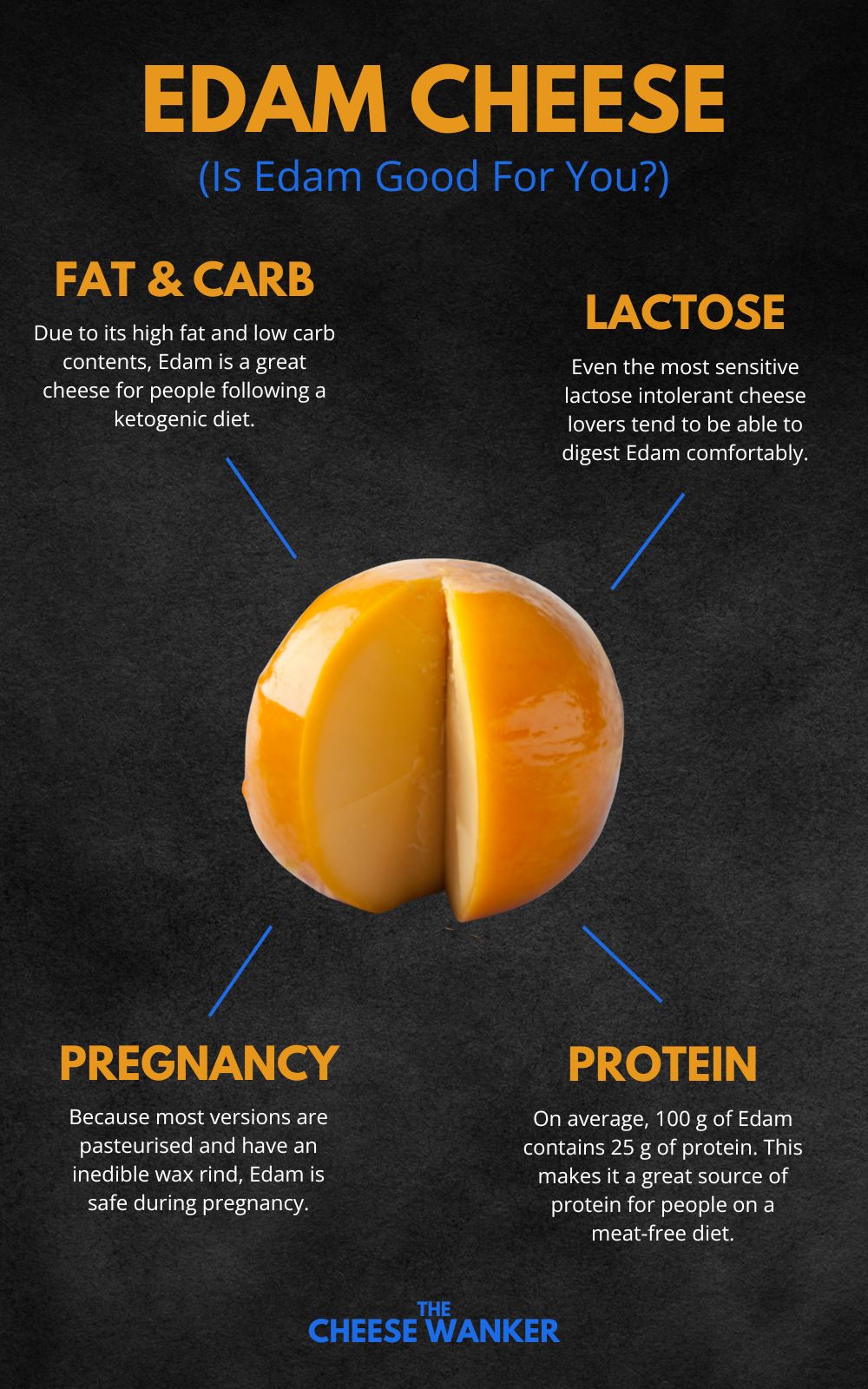
References
Overall nutritional content
The nutritional content of cheese in our table comes from the USDA Food Data Central Repository, the Australian Food Composition Database and cheese manufacturers. We realise that there can be variations between different brands and producers. Hence, the numbers we have used are averages.
Fat content
Our fat RDI data comes from Cleveland Clinic’s Healthy Fat Intake resource.
Type of fat in cheese as per Harvard T.H. Chan’s The Nutrition Source.
Protein content
Our protein RDI data comes from Harvard Medical School’s Harvard Health Publishing.
Cholesterol content
Is There a Correlation between Dietary and Blood Cholesterol? Evidence from Epidemiological Data and Clinical Interventions? – Maria Luz Fernandez and Ana Gabriela Murillo
Saturated fat, carbohydrate, and cardiovascular disease – Patty W Siri-Tarino, Qi Sun, Frank B Hu and Ronald M Krauss
Effect of cheese consumption on blood lipids: a systematic review and meta-analysis of randomized controlled trials – Janette de Goede, Johanna M Geleijnse, Eric L Ding, Sabita S Soedamah-Muthu
Safety in pregnancy
All the advice relating to what cheeses you can eat during pregnancy in this article is based on the recommendations by health authorities in Australia, the UK and the USA. If you are unsure about what you can or cannot eat, please consult your doctor.
Australia – FSANZ, United Kingdom – NHS and United Sates of America – FDA
Lactose content
Lactose residual content in PDO cheeses
Detection of lactose in products with low lactose content
The analysis of lactose in milk and cheese products by HPLC
Food Standards ANZ Food Composition Database
Lactose & Galactose content of cheese

